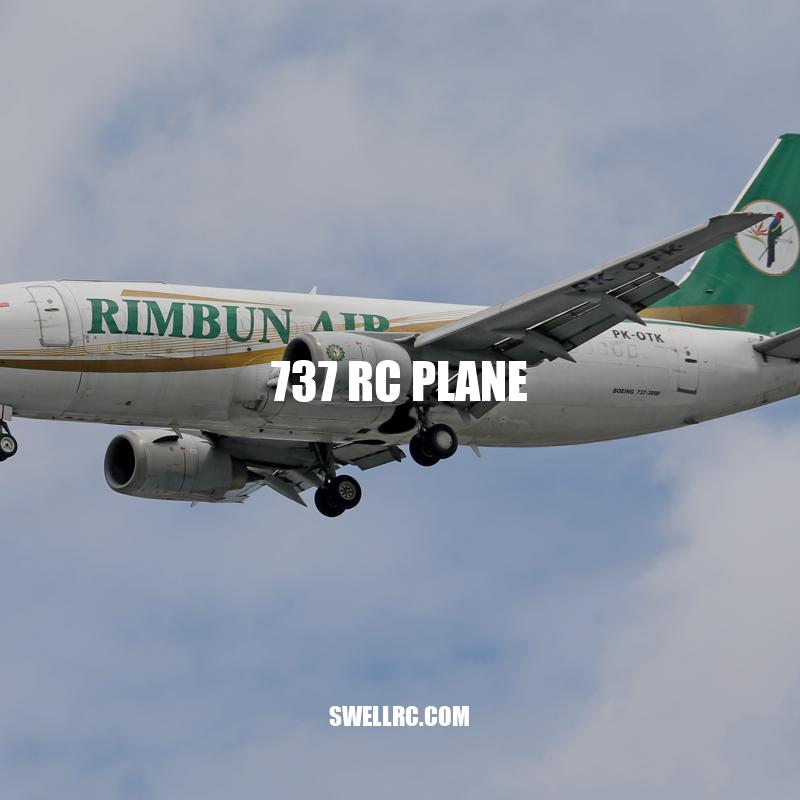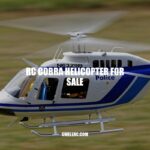Beginner’s Guide to 737 RC Planes: Building and Flying Miniature Jets
The 737 RC plane is a miniature replica of the real-life Boeing 737 aircraft that has become increasingly popular among hobbyists and enthusiasts. While remote control planes have been around for many years, the level of detail and customization available with 737 RC planes has made them stand out in the world of aviation model kits. Hobbyists can customize their planes with various livery options, and some models come with features such as retractable landing gear and working flaps. These planes require a certain level of expertise and technical knowledge to build and fly, which adds to the allure of hobbyists and enthusiasts who enjoy the challenge of building and piloting their own aircraft. The Boeing 737 is one of the most recognizable and widely used aircraft in the world, and its popularity has translated over to the world of miniature planes, making it a go-to option for collectors and aviation aficionados.
Types of 737 RC Planes
There are various types of 737 RC planes available in the market for hobbyists to build and collect. These planes range in size, power, and design, making them perfect for enthusiasts with varying skill levels and interests. Here are some of the popular 737 RC plane models:
- Boeing 737-400: This model is one of the more popular types of 737 RC planes. It is known for its ease of use and simplistic design, making it a great starting point for beginners.
- Boeing 737-800: This model is a bit more complex but is well-suited for intermediate hobbyists who want to take their skills to the next level. It comes with features such as retractable landing gear and realistic detailing.
- Boeing 737 MAX: This is one of the newest 737 models available in the market. It boasts cutting-edge technology, and the RC plane model remains faithful to the design of its real-life counterpart.
- Boeing 737-300: This model is an older version of the Boeing 737 but is still popular in the world of miniature planes. It is known for its durability, making it perfect for collectors who want to keep their planes for years to come.
Enthusiasts can find 737 RC plane kits and models at various online stores and marketplaces, such as Amazon and eBay. There are also websites and forums dedicated to the world of RC planes, offering tips, resources, and guides for hobbyists and enthusiasts. Aspiring builders and collectors can find detailed information and tutorials on building and customizing their own 737 RC planes on websites such as RC Groups and The Scale Modeler.
What model plane is Ryanair?
Ryanair is a popular low-cost airline that operates across Europe. When it comes to their model planes, Ryanair primarily uses the Boeing 737-800. This aircraft model is one of the most commonly used planes in the aviation industry, known for its efficiency and reliability. The Boeing 737-800 has been customized to fit Ryanair’s needs, including a bright blue and yellow color scheme and additional seats for more passengers. This plane can hold up to 189 passengers, making it a great choice for Ryanair’s large customer base. With this model, Ryanair is able to provide safe and comfortable flights at an affordable price.
Building a 737 RC Plane
Building a 737 RC plane from scratch can be a rewarding experience for enthusiasts who are up for the challenge. Here are some of the things hobbyists need to know before they begin:
- Materials: Building a 737 RC plane will require various materials such as balsa wood, foam boards, and adhesives such as epoxy and glue.
- Tools: Hobbyists will need a range of tools to complete the project, such as hobby knives, sandpaper, and a ruler.
- Expertise: Building a 737 RC plane requires a significant degree of expertise, especially when it comes to working with precision instruments and following strict instructions, so enthusiasts should be prepared to invest the time and effort needed.
An option for beginners is to purchase a pre-made kit that includes all the required materials and instructions. This removes the need for expert knowledge, and hobbyists can start building the model right away. Experts can opt for a more complex approach, building the models from scratch. Regardless of skill level, a great resource for RC airplane building is RCGroups.com, a popular online community for hobbyists. They have thousands of members who can offer tips and support throughout the building process.
List of Required Materials for Building a 737 RC Plane
| Materials | Function |
|---|---|
| Balsa wood | Used for the plane’s frame and body |
| Foam boards | Used for wings and other structural components |
| Epoxy and glue | Used to bind and secure the parts of the plane |
| Hobby knife | Used for precise cutting of materials |
| Sandpaper | Used to smooth and shape materials |
| Ruler | Used for measuring and ensuring accurate dimensions |
What materials do you need to make an RC plane?
Making an RC plane can be an exciting and rewarding project for aviation and technology enthusiasts. The process of putting the pieces together requires creativity, precision, and knowledge. And when it comes to choosing the materials to make the RC plane, you must prioritize durability, weight, and aerodynamics.
So, what materials do you need to make an RC plane? Firstly, you will need foam or balsa wood to construct the body of the plane. Balsa wood is a popular choice because it’s lightweight and easy to carve. However, foam is a good alternative, especially if you’re a beginner. Foam is easier to handle, cheaper, and more forgiving when you make mistakes.
In addition to the body, you will need a motor, a propeller, and a battery to power your RC plane. The motor and propeller are responsible for generating thrust, and the battery is the energy source that powers the motor. You can choose a brushed or brushless motor, but brushless motors are more efficient and durable. The propeller size will depend on the size and weight of your RC plane.
You will also need servos to control the movement of the plane’s parts, such as the flaps, ailerons, and rudder. The servos translate your commands into mechanical movements, so it’s crucial to choose high-quality servos that can handle the load and provide accurate movements.
Lastly, you will need a radio control system to command your RC plane. The radio control system consists of a transmitter and a receiver. The transmitter is the handheld unit that you use to send signals to the receiver installed on the plane. You must choose a reliable and high-quality radio control system to ensure smooth and safe flight.
In conclusion, making an RC plane requires several materials, including body materials, a motor, a propeller, a battery, servos, and a radio control system. Choosing the right materials is crucial in ensuring a successful and enjoyable RC plane-building experience.
Flying a 737 RC Plane
Flying a 737 RC plane requires more than simply building the model. Here are some key things to keep in mind:
- Equipment: In addition to the plane, hobbyists will need radio equipment, such as a transmitter and receiver, to operate the 737 RC plane.
- Charging: Hobbyists need to ensure batteries are fully charged before flying, and the radio equipment is fully operational.
- Pre-flight checks: Conduct pre-flight checks to ensure the plane is operating safely.
- Takeoff: For takeoff, hobbyists need to ensure the 737 RC plane is facing the wind direction, and gradually increase the throttle to gain altitude.
- Landing: Landing can be tricky, hobbyists need to control the descent, cut off the throttle and maintain glide until the plane descends slowly and safely to the ground.
- Maneuvering: Once the plane is in the air, hobbyists can control the movement with the radio equipment. It’s important to exercise caution and avoid flying over restricted areas or near airports.
One of the best things about flying a 737 RC plane is the freedom it affords hobbyists to choose where to fly, as long as they follow national flying regulations and common sense safety habits. Hobbyists should keep in mind that the weather can affect the safety and control of the plane. Rain, high winds, and other inclement weather conditions can interfere with the equipment and the plane, sometimes leading to crashes. To keep themselves informed and updated on local flying conditions, hobbyists can join the Academy of Model Aeronautics, a non-profit organization that offers support, tutorials, and safety measures to RC plane hobbyists.
How big of an area do you need to fly an RC plane?
When it comes to flying an RC (remote control) plane, the size of the flying area is important. The required area depends on the type of RC plane you have and your level of experience.
For beginners, it is recommended to fly in an open space with no obstacles such as trees, buildings or power lines. A park, a field or an open area is a good option. The ideal size for beginners would be around a football field or roughly 50 meters (164 feet) in length and 30 meters (98 feet) in width. This size provides a sufficient amount of space to maneuver the plane and make mistakes without causing any damage.
However, if you’re an experienced pilot or have a more advanced RC plane such as an aerobatic or racing plane, you may require a larger space. For instance, racing planes need a longer and straighter runway to reach high speeds, so an open area with around 70 meters (230 feet) in length and 50 meters (164 feet) in width is recommended.
In summary, the size of the flying area depends on the type of RC plane and your level of experience. It is always better to err on the side of safety and opt for a larger area rather than a smaller one. Remember to check your local laws and regulations before flying in a public area to ensure compliance.
Benefits of Owning a 737 RC Plane
Owning a 737 RC plane can be a worthwhile experience, providing a range of benefits for enthusiasts. Here are a few:
- Enjoyment: Owning and operating a 737 RC plane can be a fun and fulfilling hobby, allowing enthusiasts to connect with their inner aviation enthusiast and explore new sets of skills.
- Education: Building, maintaining, and flying a 737 RC plane can offer a valuable educational experience, teaching enthusiasts about aviation and engineering.
- Career opportunities: Aspiring aviation professionals can benefit from owning and working with RC planes, providing a pathway to more advanced careers in aeronautics.
- Networking: Joining local RC plane groups or organizations can provide networking opportunities, where enthusiasts can meet other like-minded hobbyists and share experiences.
- Therapeutic: Flying a 737 RC plane can also be therapeutic, providing stress relief, relaxation, and an escape from the pressures of everyday life.
To take full advantage of these benefits, enthusiasts can explore various online communities, clubs, and websites that cater to the RC plane community. The Academy of Model Aeronautics is one such website that provides resources and support to RC plane hobbyists. Additionally, websites like Flitetest, RCGroups, and Modelflyingforum offer various tutorials, ideas, and discussions related to 737 RC planes.
How much does it cost to join the Academy of Model Aeronautics?
The Academy of Model Aeronautics is a non-profit organization that aims to promote the safe operation of model aircraft. If you’re interested in joining this organization, you may be asking yourself, “How much does it cost?” Well, the answer is that the cost varies depending on a few factors.
First, there are different types of memberships available. For example, if you’re a new member, the cost of a regular adult membership is $75 for the first year. But if you’re under the age of 19, you can join as a youth member for only $38.
If you’ve been a member before and are looking to renew your membership, the annual cost is $75 for regular adult members and $65 for senior members who are over the age of 65. Youth renewals are only $31.
Additionally, if you’re a member of an affiliated club, you can receive a discount on your AMA membership. The cost for affiliated club members is $65 for regular adults and $38 for youth members.
It’s important to note that these prices are subject to change and may not include additional fees such as postage and handling. However, becoming a member of the Academy of Model Aeronautics is a valuable investment for those interested in model aviation. Not only do you gain access to a community of like-minded individuals, but you also have access to educational resources, insurance benefits, and more.
Conclusion
In conclusion, 737 RC planes offer a rewarding and educational experience for aviation enthusiasts and hobbyists alike. Building, maintaining, and flying these miniature jets can provide a range of benefits, including enjoyment, education, career opportunities, networking, and therapeutic value. For those interested in pursuing this hobby, there are a variety of resources and communities available online that provide support, guidance, and inspiration, as well as tools and materials needed to start building and flying. If you are passionate about aviation, engineering, or just looking for a fun and unique hobby, then 737 RC planes may be the perfect fit for you!



